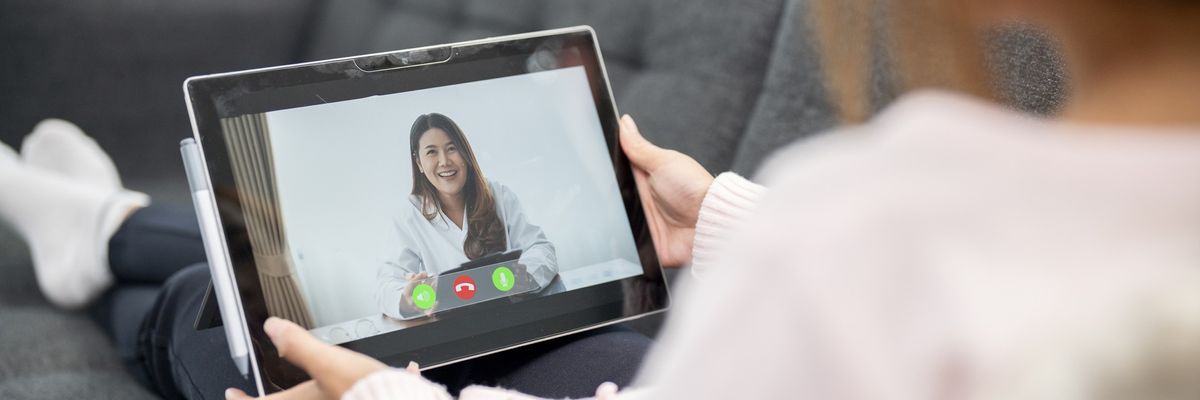In an ironic twist, people recovering from opioid addiction recently gained permanently expanded access to telemedicine services through a new federal policy—but many are likely to be among the 22 million low-income households losing access to affordable internet.
The Federal Communications Commission recently began to wind down the Affordable Connectivity Program, the country’s largest, most successful internet affordability program. This government-sponsored benefit program, introduced during the pandemic, provides low-income Americans with a one-time subsidy to purchase an internet-capable device and monthly subsidies for broadband services.
As a physician delivering telemedicine-based addiction care to rural and low-income communities, the Affordable Connectivity Program has been the essential linchpin for creating telemedicine access to lifesaving medications for opioid use disorder.
I urge Congress to renew funding for the Affordable Connectivity Program and pursue legislative pathways to permanently expand internet access to all.
Substance use disorders are life-threatening chronic conditions, but they’re treatable. More than 70% of people with substance use disorders transition into recovery. However, early recovery is fragile. When people are ready to engage in care, low-barrier, rapid access to care is vitally important to support treatment success, especially during reentry from incarceration when the overdose risk is up to 129 times greater than community-based populations. Nearly half of people using opioids in rural areas were recently incarcerated, emphasizing the need for expanded rural access to treatment.
Yet, in-person addiction care is disproportionately limited in rural communities, requiring long drive times to access care. This is simply not an option for most of my patients, particularly those in early recovery. Most are trying to rebuild their lives while confronting significant financial debts incurred during past periods of expensive, prolonged substance use and incarceration. Stigma locks them out of high-earning positions, effectively segregating them to low-wage positions with limited opportunities for advancement and usually no access to benefits like paid time off to engage in care.
Many of us can get a leg up during hard times from family or peers. However, most patients in early recovery are at the starting line of repairing social relationships weakened by trust lost during active substance use and prolonged absence during incarceration. Often, the social supports they can access are facing similar resource-limited circumstances, with minimal ability or bandwidth to help with transportation or finances.
Every day, my patients choose what they can afford from a menu of necessities.
What will you have today?
- Food
- Transportation to work
- Cellphone access
- Savings toward rent
- Fees to obtain a driver’s license
Rarely can they cover more than one or two at a time. How could expensive, time-intensive travel to distant healthcare ever compete?
It shouldn’t have to. And thanks to the relaxation of telemedicine rules and the Affordable Connectivity Program, it hasn’t had to.
While the Affordable Connectivity Program’s $30 monthly subsidy sounds inconsequential, the true value of costs saved is much higher, as the collateral costs (e.g., transportation, lost-wages) of in-person services are avoided. With reliable access to data plans, my patients attend their medical appointments from their worksites during their lunch breaks or easily negotiate alternative breaks with their bosses, who are more willing to be flexible because work can quickly resume when patients remain on-site. This has allowed patients to consistently receive addiction treatment without incurring lost wages and transportation costs during the two-to-four-hour long process of in-person care. With their financial distress tempered, my patients have more quickly transitioned from survival mode to future planning.
The Affordable Connectivity Program also enabled internet access to key social resources that promote health and stability. My patients have taken online classes, searched and prepared for jobs, and built healthy social connections with online recovery communities, the latter particularly key for rural patients with limited in-person social options.
Funding for the Affordable Connectivity Program is projected to run out in April unless Congress acts quickly to renew funding. Amidst the Affordable Connectivity Program’s wind down, my team has begun switching patients to the remaining alternative telecommunication benefits for low-income households, like the Lifeline program. However, this inferior program provides only $9.95 monthly toward internet service—insufficient to cover the entire cost of a plan—and limited options of qualifying service providers. For my patients battling homelessness living in tents, cars, and motel room rentals while working tireless hours to survive and endeavor toward stable thriving, a $20 increase in monthly expenses is insurmountable.
The communities with significantly limited internet access—rural, low-income, Black—are also disproportionately impacted by the opioid crisis and low access to in-person treatment. Their precarious internet access falsely positions the internet as a luxury, rather than an essential resource for healthcare, education, employment, transportation, and social belonging. Internet access is a health equity issue.
I urge Congress to renew funding for the Affordable Connectivity Program and pursue legislative pathways to permanently expand internet access to all. Without swift action, I fear that losing the Affordable Connectivity Program will lead to more lives lost to treatable substance use disorders.
